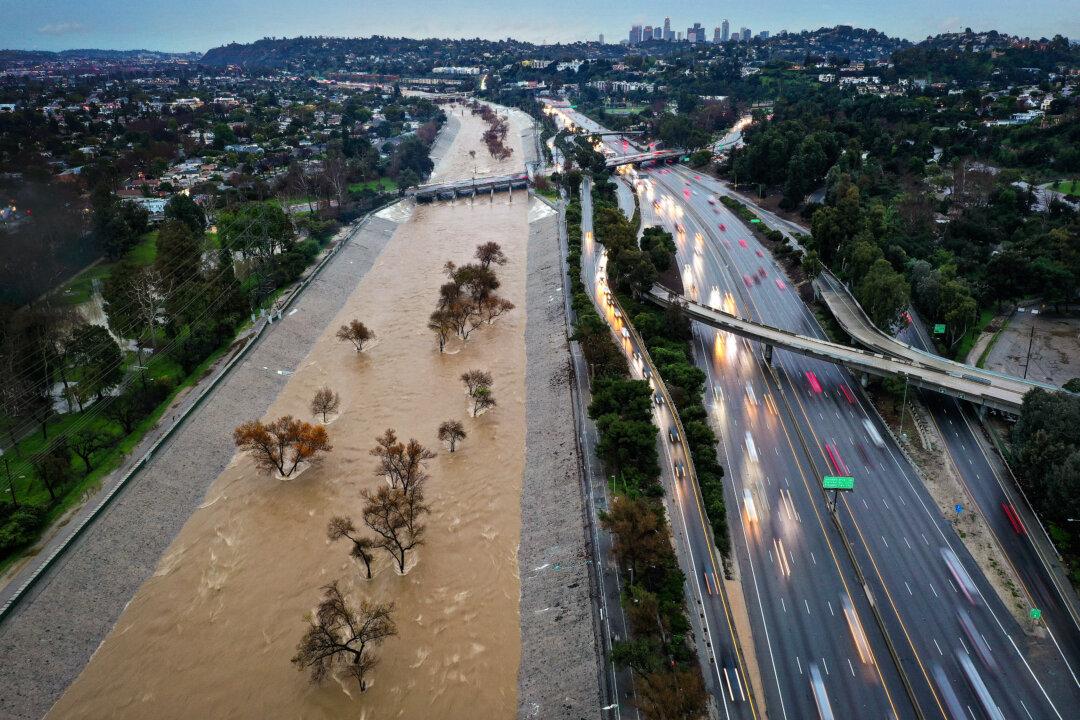A lack of infrastructure to capture stormwater in California leads to nearly 740 billion gallons washing out to sea every year, according to a newly released report.
The researchers included rainfall on roofs, roads, and other urban areas in their estimate but didn’t count rainwater that percolates into the ground or enters streams and waterways without contacting hard surfaces.
The report found that approximately 59.5 million acre-feet—one acre-foot equals about 326,000 gallons—per year of urban stormwater runoff across the country. Such is equivalent to about 53 billion gallons per day.
He said urban communities across the nation are facing concerns over water supplies, flooding, and drought.
“There is vast opportunity for stormwater capture strategies to help solve many of these challenges, enhancing overall water resilience,” Mr. Berhanu said.

About 37 percent of the national runoff total occurs in coastal areas where more opportunities exist to capture stormwater because of reduced impacts on those who hold water rights downstream, the researchers concluded.
In California, about 1.54 million acre-feet per year of stormwater are lost in such coastal basins, representing more than half of the 2.27 million acre-feet per year of runoff across the state.
Most stormwater runoff occurs in the Los Angeles, San Diego, and San Francisco regions of the state. More water is lost in the City of Angels than in any other area in the West, with the city ranked 19th among urban areas nationwide.
While California receives a small amount of annual precipitation in urban areas—about 16 inches per year, compared to an average of 40 inches annually in urban areas across the nation—the region has a relatively large urban land area of about 5 million acres.
The Golden State ranked ninth nationwide for stormwater runoff, and authors estimated that Texas loses the most stormwater—about 7.8 million acre-feet per year—with Florida’s 4.12 million acre-feet placing second.
Researchers concluded that stormwater capture is underutilized nationwide and argued that communities could benefit from improving strategies and policies at the state and federal levels.
Such strategies include improving gray water infrastructure such as storm sewers and storage ponds, in addition to so-called green infrastructure, including raingardens and other landscaping that use plants and soil to slow water runoff, as well as filter and store the water in underground aquifers.
Other approaches are manageable at smaller scales; for example, stormwater that lands on roofs can be stored in cisterns or rain barrels for use during droughts. One organization, MEarth—a nonprofit environmental group in Carmel, California—is using a “green” roof utilizing plants and soil to assist with the water capture, as noted by the report.
The authors also highlighted efforts undertaken at the National Mall in Washington, where stormwater is captured and stored for reuse underground in a system that treats and distributes water to irrigate the lawn.

Once seen as a nuisance, stormwater is now being viewed as a potential asset by some state and local governments, though limited regulations exist that specifically address the issue, according to the report.
Researchers said that such creates uncertainty and limits the ability of stormwater infrastructure development, with the authors emphasizing a need for federal guidance and funds to facilitate further research and implementation of water capture projects.
Water Storage Update
Trillions of gallons of rainfall washed away across California during recent storms, but the state took a host of actions last year that put it in a position to capture more water, a spokesperson told The Epoch Times.The Santa Anita dam retrofit project in Los Angeles County is already yielding results, according to the Natural Resources Agency. The state invested $10.5 million last year to improve the operational capacity of the dam, with water-saving estimates yet to be determined.
A project known as the Sites Reservoir—proposed near Sacramento—would increase capacity in the region by about 15 percent, according to state water board statistics. Construction is expected to begin in mid-2026, as estimated by the California Water Commission.
Additionally, the state is facilitating the approval of seven water storage projects conducted by local agencies around the state that would increase storage capacity by nearly 3 million acre-feet.
Statewide totals show an average of 13 inches of rain since the wet season began in October 2023, and reservoirs are averaging 118 percent capacity, according to the state’s water board.
Details about water captured and washed away this year will be available in the coming months, according to California’s Natural Resources Agency.
Contributing to storage constraints in the state are aging infrastructure projects, with 112 dams graded “less than satisfactory” by state inspection officials. Out of concern for public safety, water levels in 41 of the dams are maintained below capacity—resulting in a total loss of 350,000 acre-feet per year across California.







